AAC users9 October 2021
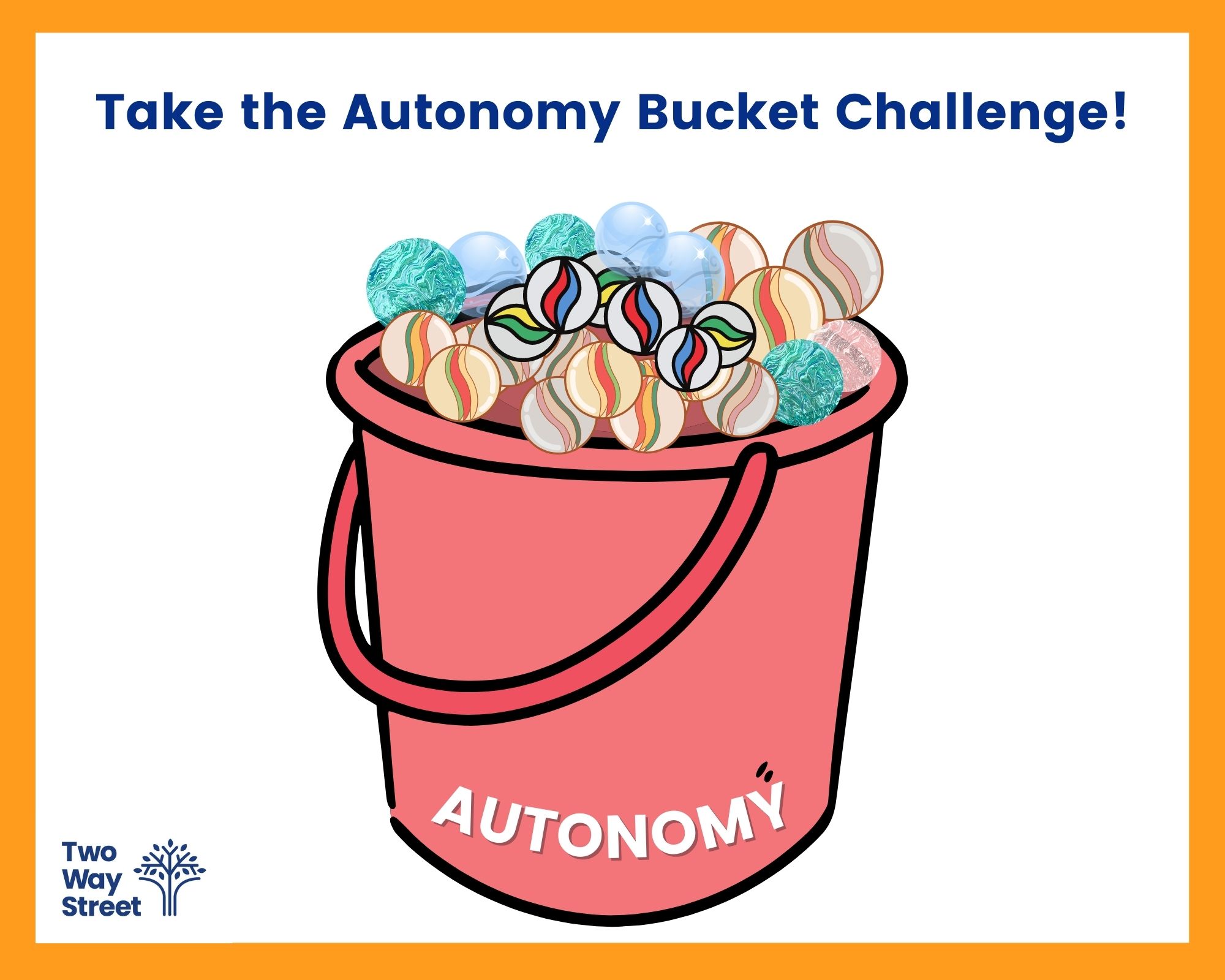
Let’s find more of those autonomy marbles…
The Merriam Webster Online Dictionary defines autonomy as:
the state of existing or acting separately from others.
Autonomy is one of the key psychological needs that drives human behaviour – it both empowers and motivates us. Within a society, we can’t always be autonomous. We are supposed to follow or comply with rules and social norms at least some of the time. Some of us seek more autonomy and choose activities that are less structured, some may even choose to resist or protest. Others may be happy to comply, or prefer to go along with someone else’s agenda some of the time. Governments the world over allow their citizens different levels of autonomy and communities, schools, workplaces and families balance autonomy and compliance all of the time. Though it is important that we comply with rules and social standards in many ways, it is autonomy that lays the foundation for motivation, engagement, and self determination. Think about the type of person you are and how often you exert your autonomy or comply with rules or standards throughout your daily life.
Now think about the person you know who has CCN (complex communication needs).
Autonomous communication is crucial to our overall autonomy. Gayle Porter (2018) describes communication autonomy as communicating according to our own intentions or, put more simply, the individual is able to say what I want to say, to whoever I want to say it to, whenever I want to say it, however I choose to say it. Consider how many times a day a person with fluent verbal speech is able to say what they are thinking, and the variety of those messages throughout our day as they interact with others.
Now think about the person you know who has CCN.
Sometimes our communication is less autonomous, and takes the form of answering questions posed by others (such as when we visit the doctor or dentist), other choosing from a list of options that someone else has prepared (eg. menu items at a restaurant, or which movie we will see at the cinema). What percentage of your daily communication would you say is like this? For me it’s easily less than about 5%.
Now think about the person you know who has CCN.
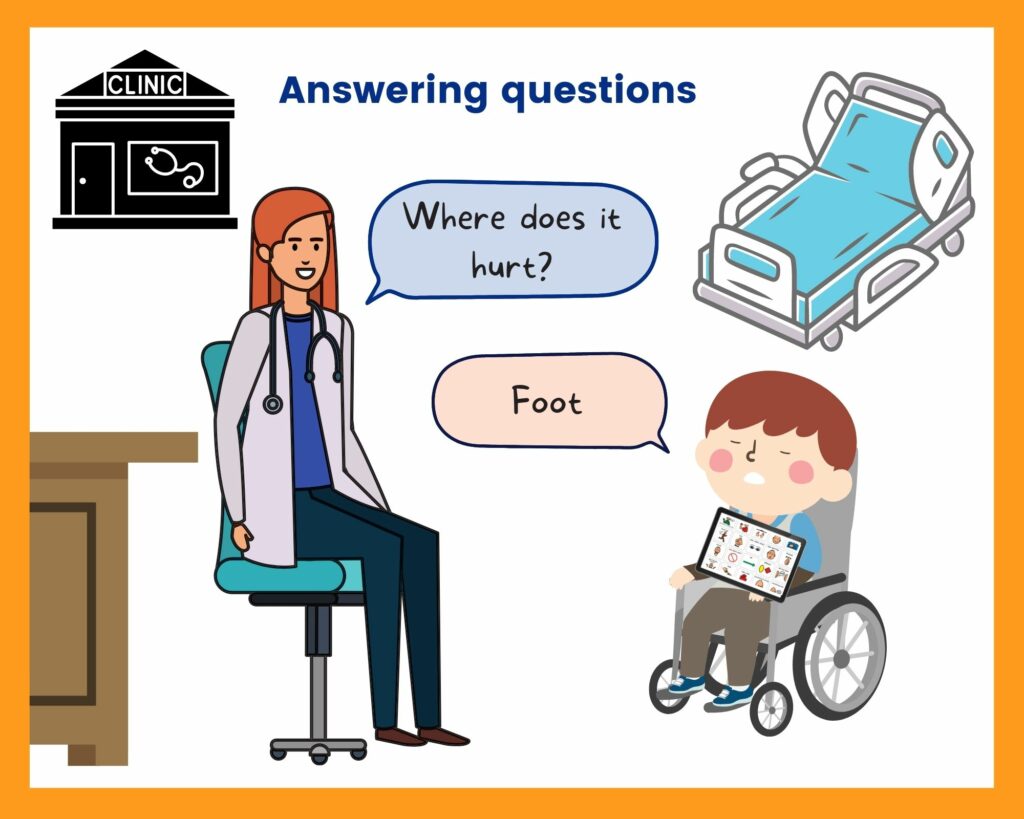
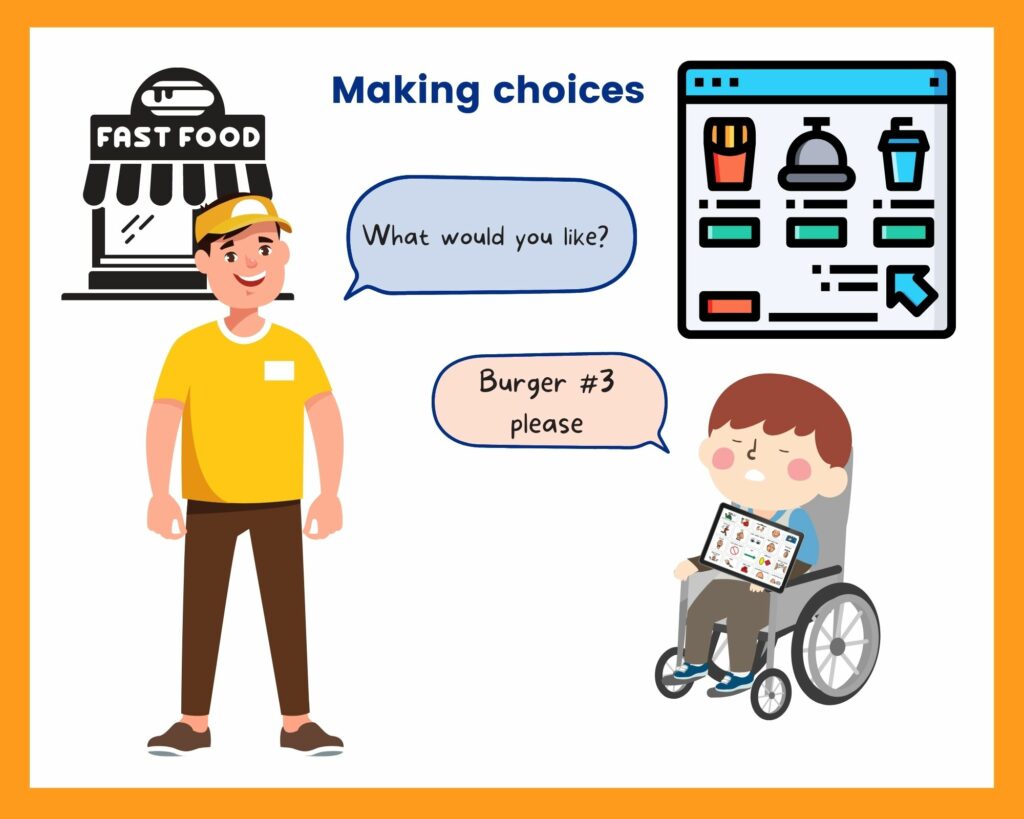
Most of us are okay with these less autonomous interactions because they are such a small percentage of our messages. As well, we often pair a compliant message with an autonomous one to make sure we maintain control of what happens to us. Here are some examples:
Now think about the person you know who has CCN.
Being able to say what we are thinking helps us feel calm and safe that we can influence what happens to us. Sometimes other people might try to predict what we are going to say and jump in before us. While this could be fun or beneficial if we are playing charades, or have just taken a bite of food, it is mostly frustrating and disempowering.
Now think about the person you know who has CCN.
Erin Sheldon (2019) described autonomy and compliance as either sides of a balance scale. She explained that whenever we are being compliant, we are not being autonomous and vice versa. Adding to one, takes away from the other. We are not autonomous when we comply with rules, or even when we have to choose from the menu at a restaurant. Of course we have a choice, but we must choose something that the restaurant has made available to choose.
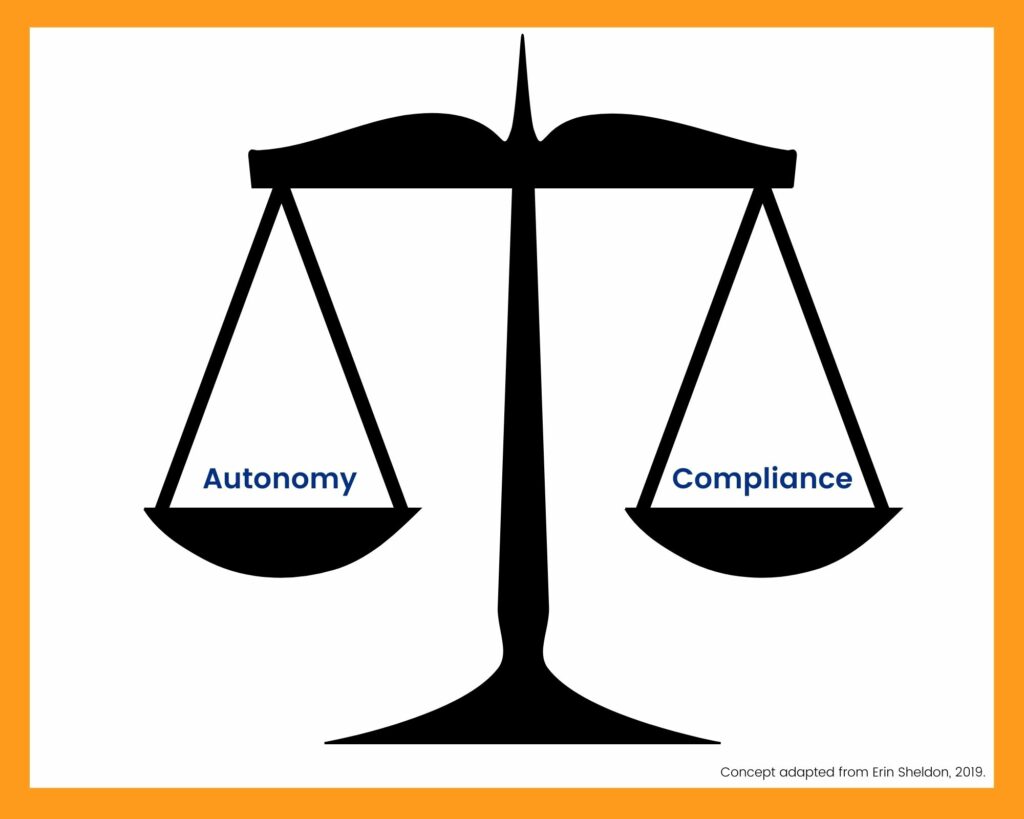
In terms of building communication autonomy, I like to think of the autonomy and compliance scales as having a bucket on each side and throughout the day we drop marbles into each bucket.
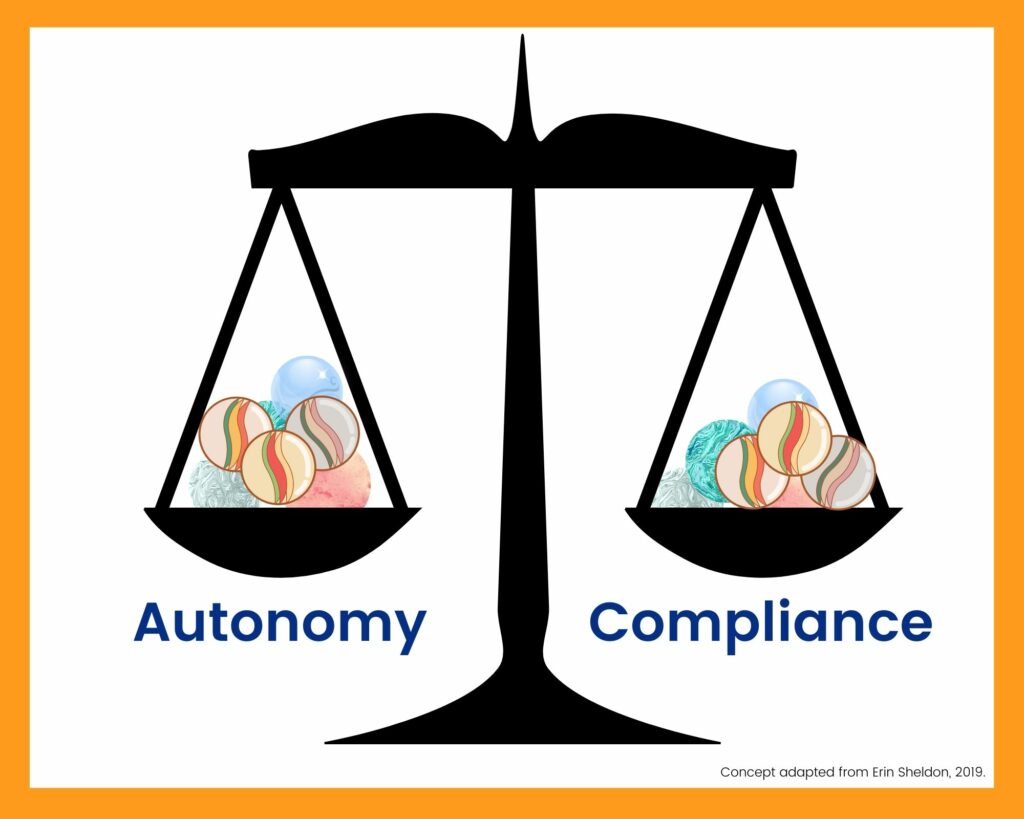
Though all of us collect compliance marbles throughout the day, we also gather a big pile of autonomy marbles to balance them out.
| Typical interactions where autonomy is paired with compliance. | Compliant messages only (answering questions or making choices) which tends to happen when someone is still developing expressive language skills. |
|---|---|
| Doctor: Where does it hurt? Patient: Well on my foot mostly but also my leg gets really itchy. But it only happens sometimes. | Doctor: Where does it hurt? Patient: Foot. Leg. |
| Waiter: What can I get for you? Diner: Does the salad have eggs in it? Waiter: Yes it does. Diner: Ok, I’ll have the stir fry instead. | Waiter: What can I get for you? Diner: Stir fry. |
| Friend: Do you want to go for a coffee? You: Sure. When? Friend: This Afternoon. What time suits you? You: Well, I have to go for a run first, so is 4pm OK” | Friend: Do you want to go for a coffee? You: Yes Friend: This Afternoon. 2pm You: Yes (and miss your run) or No (and miss the coffee). |
Now think about the person you know who has CCN.
How does their balance scale look? Often we see the autonomy marbles are in short supply, and the opportunities to collect them are even less. So our challenge is to balance the scale with autonomy marbles whenever we can.
Jasmine is a 12 year old girl. She gets up at 7am, eats breakfast and gets ready for school with the help of her parents. She catches the bus to school, arrives at 8:45 and plays in the yard til class starts at 9am. Jasmine communicates using speech and between 7am and 9am when she starts class, she is pretty much talking constantly. Anything she needs to say or tell people is autonomously spoken as many times as she chooses to say it, and often that is multiple times until she gets the response she wants, or has to change the subject. Maybe she had a bad dream, maybe she is excited about the chicks they are bringing into class today, maybe she forgot to bring her excursion note. Luckily she can tell anyone and everyone if she chooses. When she sits down for morning group and the teacher asks her questions, she is happy to answer as she feels like she has been heard and had a chance to say what she needs already.
She has already filled her bucket with autonomy marbles.
Jenna is a 12 year old girl. She gets up at 7am, eats breakfast and gets ready for school with the help of her parents. She catches the bus to school, arrives at 8:45 and plays in the yard til class starts at 9am. Jenna communicates using AAC and between 7am and 9am when she starts class, she is pretty much thinking constantly. Anything she needs to say or tell people is in her head but she has to wait until someone has the time to sit with her to listen, or remembers to get her device off charge and have it available to her. Her parents are great but given her extra needs, there is a lot more to manage in the mornings and the accessible bus comes really early! Sometimes when she is not in her wheelchair, she needs others to scan on her PODD when she has something to say, but lots of people don’t notice when she wiggles her body to say “Hey, I’ve got something to say”. Maybe she had a bad dream, maybe she is excited about the chicks they are bringing into class today, maybe she forgot to bring her excursion note. Unfortunately she can’t always tell anyone and everyone if she chooses. When she sits down for morning group and the teacher asks her questions, she might use this as an opportunity to talk about her bad dream, or maybe she has learned that she doesn’t fit in here, or that people won’t take the time to listen so she just listens but doesn’t participate.
Jenna needs some autonomy marbles in her bucket first if we want her to successfully participate in her class activities.
How do we do this?
Of course, there will be situations where we need compliance both in behaviour and communication. All of us need to answer questions and make simple choices regularly throughout our week (e.g., “Are you dining in?” or “Do you want pasta or sandwiches for lunch today?”), but we should focus more on finding as many autonomy marbles as possible to balance out the scale. We call it the Autonomy Bucket Challenge for those who are communication partners to people who have complex communication needs, and here are some ideas…
At first, autonomous messages may not always be expressed in symbolic form. We may need to watch and listen for examples of autonomy and then model the language that maps onto what they are already telling us with their body. Other times we may need to wait until the person shows us they have something to say rather than just asking them a question or trying to get them to say something.
For those who are already using symbolic language within their AAC system, try to cut back on yes/no questions and just give them an opportunity to share something, or at least ask an open rather than closed question. Maybe you could even just tell them something that’s on your mind and then give them a chance to take a turn in the conversation – or not if they choose not to, it’s up to them.
Another key technique is to let go of your own agenda. To quote Daniel H. Pink, “control leads to compliance: autonomy leads to engagement”. Oftentimes, AAC systems are used to find out what we want to know from a person rather than what they want to tell us. Consider Jasmine again, maybe we ask her “What did you do at school today?” and she ignores our question saying “My friend got a new puppy?” She is more interested in talking about the puppy than what she did at school, and will become less engaged if we keep trying to talk about school rather than the puppy.
Though we may often think that we know what a person is going to say, quite often we are wrong. If we make assumptions about what someone who uses AAC is going to say, we tend to only give them the chance to say what we thought they were going to say, not necessarily what they wanted to say.
This might happen if:
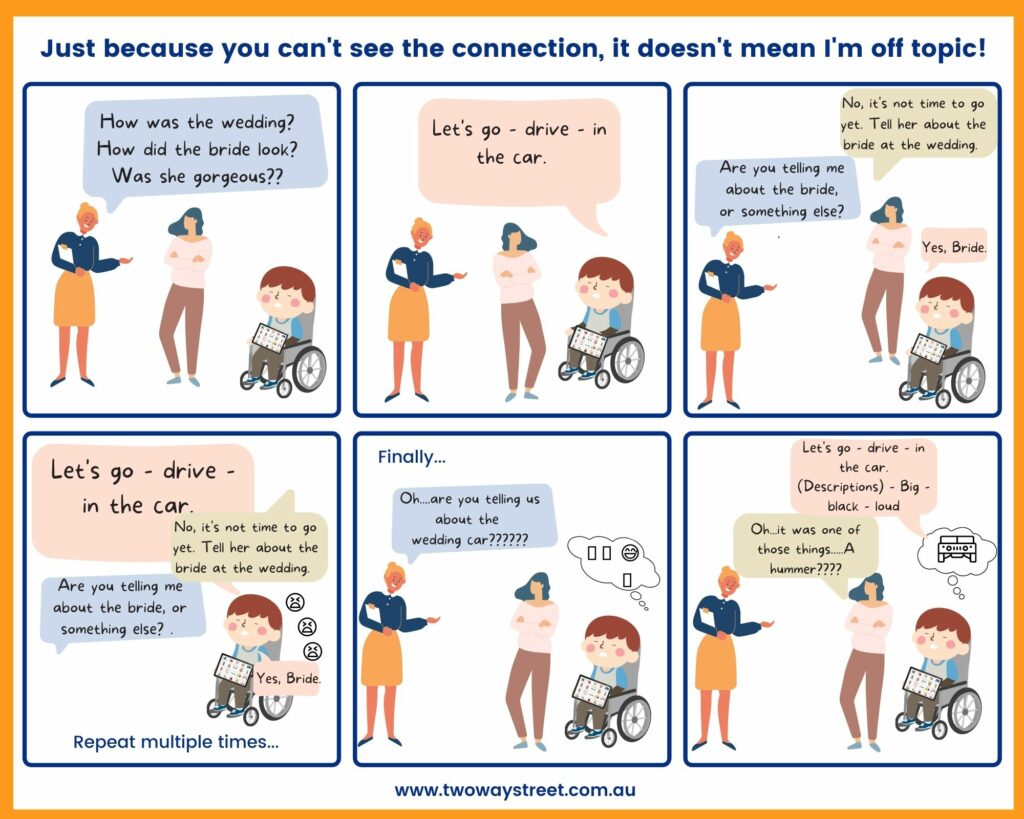
So take the challenge and see where it leads you. Think about ways that you can find autonomy marbles for the person you know who has CCN. It’s okay to include some compliance marbles along the way, but just put an autonomy marble in the other bucket first.
Here are some ways you can do this:
Just remember that we all need autonomy. If we don’t get it one way, we will look for it elsewhere. If you don’t let individuals say autonomous things they will exert their autonomy another way and this may be through body language, resistance, avoidance or even challenging behaviours.
There are so many ideas and strategies to encourage autonomous messages, we can’t put them all into this blog. Hopefully, we’ve just given you some thinking points for reflection. What we know for sure is that autonomous messages are the ‘Gold’ that we seek as we support those who are learning to communicate using AAC. The more marbles in that Autonomy bucket, the more they will be motivated to express themselves more frequently and with greater sophistication.
When we hear what someone is thinking rather than just what we want them to say, we learn who they are, we connect with them, and we have true conversations. As we gather autonomy marbles, we better understand our children, we better teach our students, and we can better support those people we are paid to assist.
Now think about the person you know who has CCN and take the Autonomy Bucket Challenge!
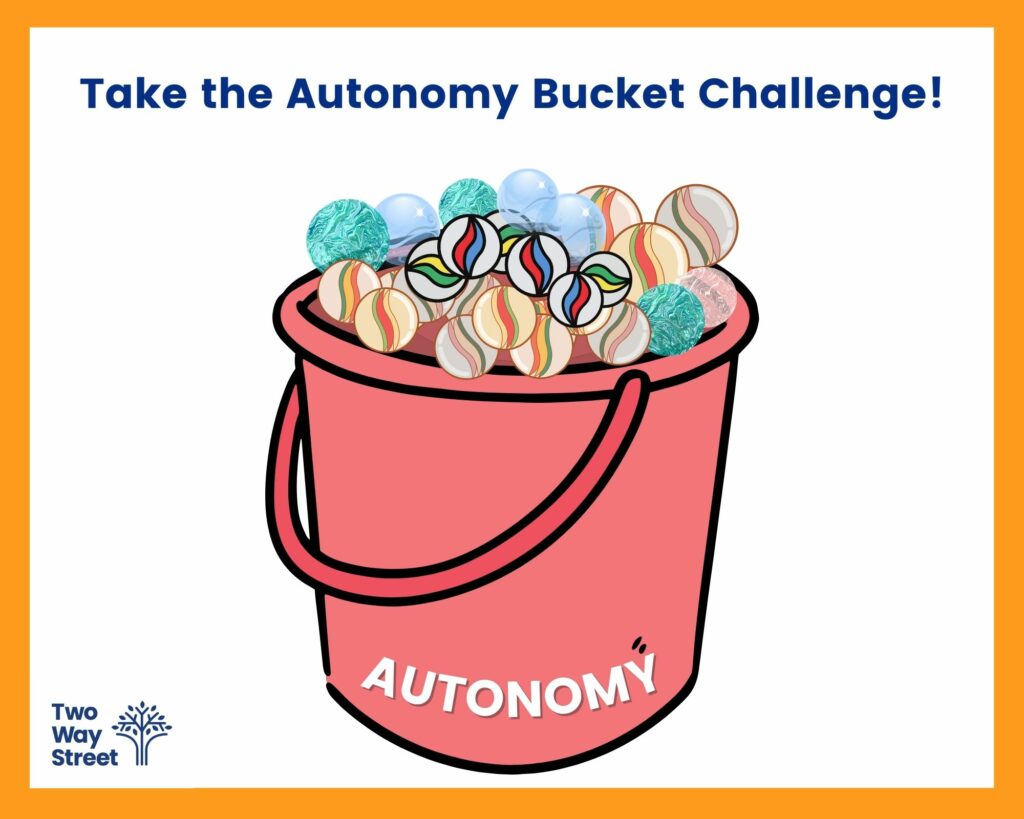
Written by: Janelle Sampson
References:
Porter, G. PODD Communication Books Introductory workshop manual © 2018
Erin Sheldon Communication for choice and control – July 11, 2019 in goodthingsinlife.org
